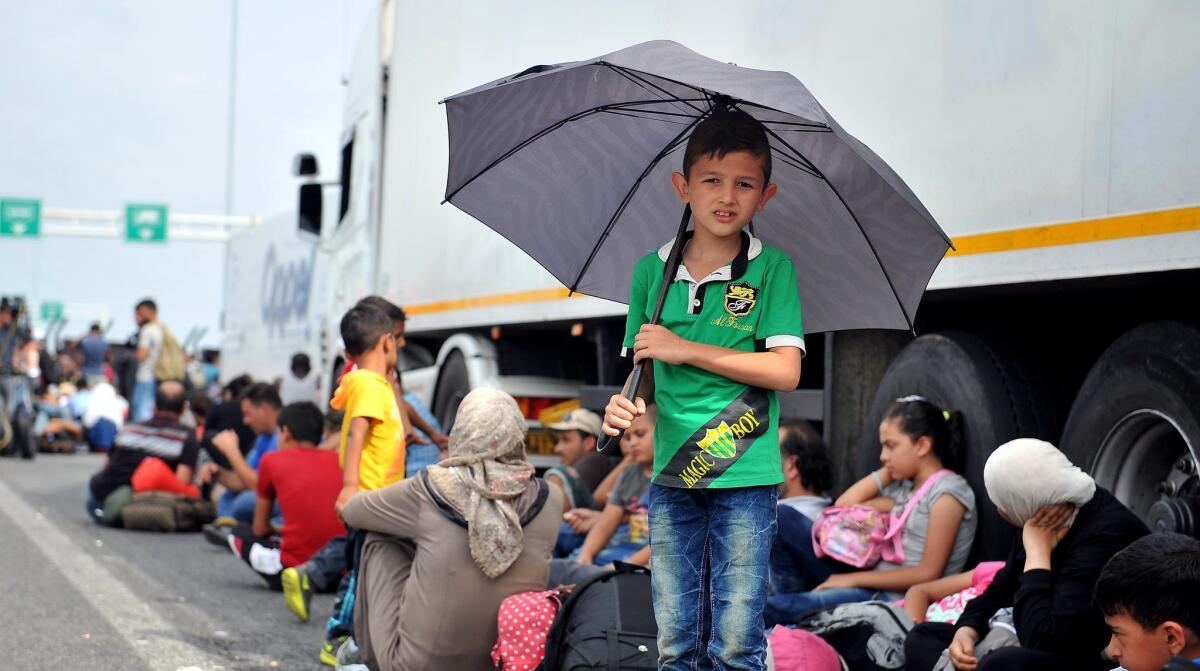Hungary shuts border crossings, triggering standoff with stranded migrants

A boy holds an umbrella as migrants and refugees sit on the asphalt of a highway at the official border crossing between Serbia and Hungary, near the northern Serbian town of Horgos, on Sept. 15.
- Share via
Reporting from Horgos, Serbia — As asylum seekers continued to pour into Europe, Hungary choked off entry Tuesday by shutting down key border crossings but immediately found itself locked in a tense standoff with thousands of frustrated migrants — and several neighboring countries.
“Open! Open!” chanted crowds stranded on the Serbian side of the border, as impassive Hungarian police officers looked on from behind locked gates.
“Germany! Germany!” others cried, shouting their desire to press northward to a country that — unlike Hungary — has flung open its doors to refugees fleeing war in homelands such as Syria and Iraq.
The migrants set up tents in the middle of the road, blocking a main highway and vowing to stay until Hungarian authorities reopened the crossing. Parents with young children settled down on the asphalt; young men rallied the crowd.
The rowdy scenes were the latest signs of the chaos engulfing Europe as it tries, so far unsuccessfully, to get a grip on its biggest refugee crisis since World War II.
In a bid to stanch the flow of refugees and migrants, the Hungarian government declared a state of emergency Tuesday in two southern counties, beefing up the powers of security forces, including the army, to patrol the frontier and crack down on those trying to sneak into the country.
It has erected a barrier of razor wire that now spans much of the nearly 110-mile line between Hungary and Serbia. As of Tuesday, damaging the barrier and entering the country illegally count as serious crimes, punishable by prison; at least 155 people have been detained on suspicion of such offenses, officials said.
But there was little indication that such draconian measures would discourage the masses of asylum seekers intent on finding sanctuary in Europe.
Human rights organizations warned that, with one route now closed, migrants would simply find other ways to get to the richer nations of Northern Europe, creating new pressure points in countries such as Croatia, Slovenia and Bulgaria rather than Serbia and Hungary.
Tragedy continues to haunt attempts to reach the continent: 22 people, including four children, drowned when an overcrowded boat carrying 271 passengers sank on the short voyage from Turkey to the Greek island of Kos, a popular migrant route, the Associated Press reported. On Sunday, 34 people died in a similar incident.
“While thousands more are expected to make their way to Hungary, this raise-the-drawbridge mentality will simply redirect, but not put an end to, desperate and dangerous journeys,” Gauri van Gulik, a spokeswoman for Amnesty International in Europe, said in a statement.
The European Union has been bitterly divided in its response to the crisis, with some member nations, including heavyweight Germany, temporarily jettisoning the cherished principle of free movement within the EU and instituting spot border checks to regulate the number of asylum seekers coming in.
German Chancellor Angela Merkel on Tuesday called for an emergency summit of the leaders of all 28 nations next week.
Germany, France and other larger nations have demanded distribution of refugees according to mandatory quotas based on each country’s size and economic strength. But several Central and Eastern European states, including Hungary and the Czech Republic, have rejected the idea, noting that they have no tradition of absorbing outsiders and saying explicitly that they do not want Muslims living among them.
At a contentious meeting Monday, interior ministers from all 28 EU nations could agree only on the resettlement of 40,000 people, an almost absurd figure in light of the fact that Germany has already taken in that many refugees this month alone.
The German government says it’s prepared to accept as many as 800,000 asylum seekers this year, equivalent to about 1% of its population. A senior official suggested this week that the intake could reach 1 million, but Interior Minister Thomas de Maiziere told German television Tuesday that the official forecast remained 800,000.
De Maiziere said he favored a proposal to cut EU funding to member nations that refused to share the task of sheltering those fleeing war and persecution. But Merkel, his boss, seemed to rule out such an approach.
“I don’t think that threats are the right way to an agreement,” she said.
Hungary’s harsh treatment of migrants — virtually none of whom intend to settle in Hungary itself — has drawn sharp criticism from many of its neighbors and from human rights groups. Tensions flared with Serbia, which warned that it could not deal with the bottleneck of people trying to enter Hungary.
An estimated 200,000 asylum seekers have crossed into Hungary this year. From there, they have hopped onto trains, paid smugglers to take them on board trucks and even trekked on foot to Austria, their gateway to hoped-for sanctuary in Germany or Scandinavia.
Although a majority of Germans support their government’s decision to take in refugees, the sheer speed at which they are arriving has sent officials scrambling to find housing and other resources. Austrian officials, too, warn that they may soon run out of places to accommodate asylum seekers surging in by the thousands every day.
Hungary’s announcement of tightened controls along its border with Serbia appears to have set off a mad dash by many people desperate to cross into Hungary before the restrictive measures kicked in Tuesday.
The government in Budapest says that it is establishing centers along the border to expedite asylum requests and that anyone whose application is refused would be quickly deported to Serbia.
Given that Hungarian Prime Minister Viktor Orban has publicly stated his belief that most asylum seekers are economic migrants trying to escape poverty and not real persecution, the prospects for many stuck here on the Serbian side of the border appear bleak.
Zaher Habbal, a 29-year-old Syrian, applied for asylum, had his fingerprints taken and was promptly rejected.
“They said, ‘Get out of here, we don’t want you here, go back to Syria,’” Habbal said, visibly upset as he waved the deportation paper the Hungarian police gave him. “They said, ‘This is our country. Get out — you’re a terrorist.’ They are the most racist people in there.”
Besides the fence along the Serbian border, Hungary is also planning to build a razor-wire barrier along part of its frontier with Romania.
“It is about defending the border,” government spokesman Zoltan Kovacs said, insisting that Hungary was upholding its legal duty to maintain the integrity of the EU’s outer perimeter.
It’s unclear how officials plan to disperse the thousands of migrants here in Horgos who have vowed not to budge until Hungary lets them in. The standoff is reminiscent of a confrontation between migrants and the Hungarian government at the main railway station in Budapest earlier this month, when authorities abruptly suspended train service to Austria and Germany, marooning refugees hoping to go there.
After a few days, the asylum seekers decided to challenge the government by walking all the way to Austria, which quickly caused Hungarian officials to back down and provide chartered buses to ferry everyone over to the Hungary-Austria border.
“They have to open the gate, because there are so many people here,” said Fadi Abou Haila, a 25-year-old mechanical engineer from Damascus, the Syrian capital. “I don’t understand why Hungary is doing this. Where do they think we will go?”
Special correspondent Chick reported from Horgos and Times staff writer Chu from London.
Follow @HenryHChu on Twitter for coverage of Europe
More to Read
Sign up for Essential California
The most important California stories and recommendations in your inbox every morning.
You may occasionally receive promotional content from the Los Angeles Times.











